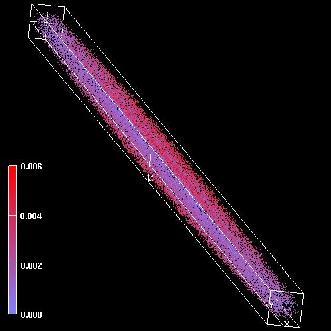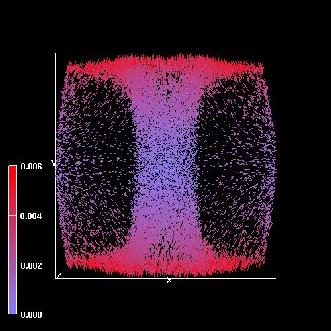This is an archival copy of the Visualization Group's web page 1998 to 2017. For current information, please vist our group's new web page.
Beam Simulation
Collaboration with R. Ryne, LBNL and J.Qiang, LANL.
The LEDA experiment is an experiment at Los Alamos National Laboratory to study the generation of halo particles in a periodic transport system. It consists of 52 alternating quadrupole magnets to provide transverse focusing. The initial beam is mismatched so that there will be a transverse envelope oscillation superimposed on the oscillation due to the periodic focusing. These envelope oscillations can drive some particles to very large transverse amplitude through a resonant mechanism. These large-amplitude particles form the so-called halo particles. Understanding halo formation and evolution is a key issue in the the design and operation of next-generation, high intensity accelerators. High resolution visualization will help to identify the halo particles and enable detailed studies of the phase space structure associated with the halo.
The following images and the movie clips: rotating view of a time step MPEG, time evolution MPEG, show the particle phase space (i.e. particle positions and transverse velocities), computed using IMPACT, for the beam propagating in the LEDA Halo Experiment.
 |
 |
IMPACT is an object-oriented three-dimensional parallel particle-in-cell code for studying high intensity beam dynamics in linear accelerators. It uses a split-operator method to combine particle-in-cell techniques with techniques from the field of magnetic optics. This allows the code to treat mean-field Coulomb interactions along with the dynamics of charged particles subject to the complex electromagnetic fields found in particle accelerators. IMPACT has been designed based on a multi-layer structure. The code includes features such as parallel dynamic load balance, restart capability, and time step sub-cycle. It has been used in a number of projects (e.g. the LEDA Beam Halo Experiment, the Spallation Neutron Source, and the CERN Superconducting Proton Linac) for beam dynamics studies around the world.